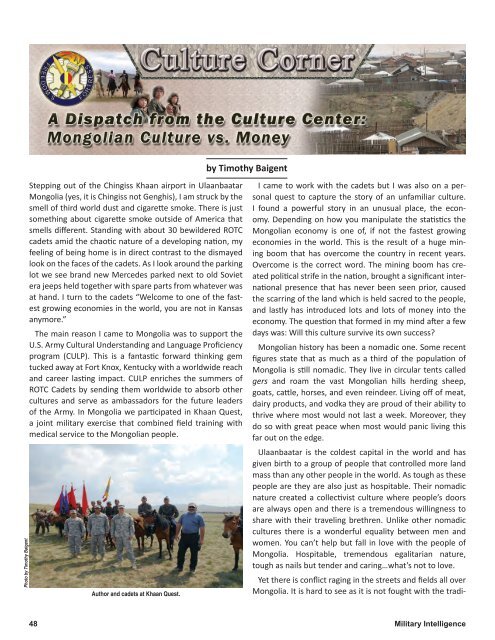2014_01
2014_01
2014_01
Create successful ePaper yourself
Turn your PDF publications into a flip-book with our unique Google optimized e-Paper software.
I came to work with the cadets but I was also on a personalquest to capture the story of an unfamiliar culture.I found a powerful story in an unusual place, the economy.Depending on how you manipulate the statistics theMongolian economy is one of, if not the fastest growingeconomies in the world. This is the result of a huge miningboom that has overcome the country in recent years.Overcome is the correct word. The mining boom has createdpolitical strife in the nation, brought a significant internationalpresence that has never been seen prior, causedthe scarring of the land which is held sacred to the people,and lastly has introduced lots and lots of money into theeconomy. The question that formed in my mind after a fewdays was: Will this culture survive its own success?Mongolian history has been a nomadic one. Some recentfigures state that as much as a third of the population ofMongolia is still nomadic. They live in circular tents calledgers and roam the vast Mongolian hills herding sheep,goats, cattle, horses, and even reindeer. Living off of meat,dairy products, and vodka they are proud of their ability tothrive where most would not last a week. Moreover, theydo so with great peace when most would panic living thisfar out on the edge.Ulaanbaatar is the coldest capital in the world and hasgiven birth to a group of people that controlled more landmass than any other people in the world. As tough as thesepeople are they are also just as hospitable. Their nomadicnature created a collectivist culture where people’s doorsare always open and there is a tremendous willingness toshare with their traveling brethren. Unlike other nomadiccultures there is a wonderful equality between men andwomen. You can’t help but fall in love with the people ofMongolia. Hospitable, tremendous egalitarian nature,tough as nails but tender and caring…what’s not to love.Yet there is conflict raging in the streets and fields all overMongolia. It is hard to see as it is not fought with the tradibyTimothy BaigentPhoto by Timothy BaigentStepping out of the Chingiss Khaan airport in UlaanbaatarMongolia (yes, it is Chingiss not Genghis), I am struck by thesmell of third world dust and cigarette smoke. There is justsomething about cigarette smoke outside of America thatsmells different. Standing with about 30 bewildered ROTCcadets amid the chaotic nature of a developing nation, myfeeling of being home is in direct contrast to the dismayedlook on the faces of the cadets. As I look around the parkinglot we see brand new Mercedes parked next to old Sovietera jeeps held together with spare parts from whatever wasat hand. I turn to the cadets “Welcome to one of the fastestgrowing economies in the world, you are not in Kansasanymore.”The main reason I came to Mongolia was to support theU.S. Army Cultural Understanding and Language Proficiencyprogram (CULP). This is a fantastic forward thinking gemtucked away at Fort Knox, Kentucky with a worldwide reachand career lasting impact. CULP enriches the summers ofROTC Cadets by sending them worldwide to absorb othercultures and serve as ambassadors for the future leadersof the Army. In Mongolia we participated in Khaan Quest,a joint military exercise that combined field training withmedical service to the Mongolian people.Author and cadets at Khaan Quest.48 Military Intelligence


